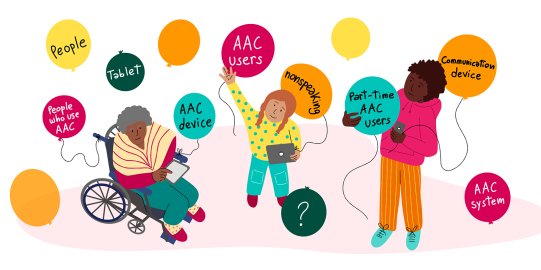On the surface, many of us might say that we don’t believe the myths and share the facts, but our decisions or the information we share unknowingly align with these myths.
This article will examine why these myths and misconceptions exist and how they continue to influence people’s attitudes and practices regarding AAC.
Overvaluing speech
AAC won’t stop speech development. A prevalent misconception is that using AAC might impede speech development. We hear this echo of an old myth when parents ask us, “Will AAC stop my child from talking?” However, research indicates that, overall, AAC supports speech development. Just as learning multiple languages or sign language from a young age can strengthen overall language abilities, AAC provides an additional means for communication and expression.
This misconception reflects a broader cultural bias known as speechism—the belief that spoken language is inherently “better” than other forms of communication. This bias manifests in various ways. For example, professionals or caregivers often prioritize speech over AAC. They treat AAC as a last resort. They do not recognize it as a valid and effective communication method. For example, Alyssa’s doctor’s office continues calling them despite Alyssa’s repeated statements that they must not do this, backed up with either not answering the call or picking up the phone, telling them to send communication on the patient portal’s messaging function, and hanging up. This insistence from the medical team illustrates a common societal preference for real-time, spoken interaction. Such biases also surface in educational and therapeutic settings, where speech is often prioritized above anything else. This speech-centered mindset fuels the belief that AAC is a fallback option rather than a legitimate and valuable form of communication.
The myth of “readiness” and prerequisite skills
One very old myth that continues to have a strong hold on the AAC community is the idea that people must prove their readiness to use AAC. This leads to people enforcing prerequisite skills to gain access to and/or use AAC. Historically, many professionals believed that people needed to demonstrate specific cognitive, motor, or language abilities before accessing AAC. Although this idea is now widely regarded as a misconception, its remnants still linger in phrases like “They’re not ready for AAC” or “They’re too low-functioning.”
These statements are rooted in outdated thinking that equates readiness to a set of prerequisites. In reality, no tests or skills must be demonstrated before someone can use AAC. Many skills previously thought to be prerequisites can actually be developed through the use of AAC.
Provide robust, comprehensive AAC as soon as a communication need is identified. If you believe a skill is necessary for effective AAC use, find ways to teach it using AAC.
Misconceptions about age and AAC use
There is also a widespread belief that AAC is only appropriate for either school-aged children or older adults who have lost speech due to stroke or neurodegenerative conditions. This binary thinking fails to recognize that people can benefit from AAC at any age or stage of life. AAC is not limited to any particular age group; it is for anyone who cannot rely on speech alone to meet their communication needs.
This misconception can prevent people from accessing AAC when they could benefit. A teen who rejected a less robust form of AAC as a younger child could use a robust system now but not be offered it because the prior attempt “failed.” A nonspeaking adult who has never been offered AAC could be mistakenly considered “too old” to learn it now, so no one tries. A toddler may not get access to AAC that could support their language development because people think they are too young to benefit — or because they’re too young to be sure their disability will affect speech. The belief that someone is “too young” or “too old” for AAC ignores that language learning is a lifelong process.
AAC benefits many people who also speak
Unfortunately, people are much less likely to consider AAC for someone who can speak, even if they can only speak a little bit. However, there is a lot of space between not being able to speak at all and being able to meet all of our communication needs with socially expected amounts of speech. This means many people who can speak still need AAC! Sometimes, AAC proves to be more comfortable or easier to use than speaking in various situations.
Much like people worry that AAC could stop speech development, people also worry that AAC could lead a person to stop using the speech they have. However, if speech is hard enough or ineffective enough that someone speaks less when given access to AAC, then not needing to use speech as much is actually a good thing.
Using AAC should be based on personal needs and preferences rather than a rigid standard about how much or how well someone speaks.
The narrow view of AAC as a single device or app
There is also a common assumption that AAC is limited to one device or app. This oversimplified view fails to recognize the dynamic and multifaceted nature of communication. AAC users often use a combination of tools and methods, including, but not limited to, gestures, writing, symbols, devices, and apps.
Using multiple AAC apps lets us pick the right tool for the right job. Different communication supports — designed for AAC or not — can complement each other, expanding communication options.
Just like a regular toolbox has many different tools for many other purposes, an AAC toolbox can have many different options for many different purposes. Switching between tools as needed tends to work better than expecting a single solution to cover all use cases.
App switching is denied when an AAC user is locked into a single app through Guided Access on a device. The user is limited to a single tool, which prevents users from utilizing their communication tools to their full potential.
Even with Apple’s newer Assistive Access feature and several allowed apps, some AAC users’ communication tools are likely missing—like YouTube, websites, photos, screen sharing, and more. These gaps leave AAC users without vital tools for full expression and interaction.
AAC users often use technological tools that were not designed explicitly for AAC. It’s important to recognize that AAC includes many different and flexible ways to communicate. Instead of thinking of it as one program for one device, let’s embrace its variety and adaptability!
Shifting the narrative
The persistence of these misconceptions is not just a matter of outdated ideas but also a reflection of deeper biases like speechism. These biases privilege certain forms of communication while marginalizing others, contributing to a lack of access and acceptance for those who use AAC. To create a more inclusive environment, we must actively challenge these myths and promote a broader understanding of communication.
This shift involves advocating for robust AAC systems and pushing back against outdated mindsets. AAC is not a last resort or a tool confined to specific age groups or abilities. It should be accessible to anyone who needs it, whenever and however they need it.
Links and References
Crowe, B., Machalicek, W., Wei, Q., Drew, C., & Ganz, J. (2021). Augmentative and Alternative Communication for Children with Intellectual and Developmental Disability: A Mega-Review of the Literature. Journal of Developmental and Physical Disabilities, 34(1), 1–42. https://doi.org/10.1007/s10882...
Donaldson, A. L., Corbin, E., & McCoy, J. (2021). “Everyone deserves AAC”: Preliminary study of the experiences of speaking autistic adults who use augmentative and alternative communication. Perspectives of the ASHA Special Interest Groups, 6(2), 315–326.
Donaldson, A. L., Corbin, E., Zisk, A. H., & Eddy, B. (2022). Promotion of Communication Access, Choice, and Agency for Autistic students. Language Speech and Hearing Services in Schools, 54(1), 140–155. https://doi.org/10.1044/2022_l...
Donaldson, A. L., Zisk, A. H., Eddy, B., Corbin, E., Ugianskis, M., Ford, E., & Strickland, O. (2023). Autistic Communication: A Survey of School-Based Professionals. Perspectives of the ASHA Special Interest Groups, 8(6), 1248–1264. https://doi.org/10.1044/2023_p...
Koerner, S. M., Glaser, S., & Kropkowski, K. (2023). Perspectives of Part-Time augmentative and alternative communication use in adults and implications for pediatric service delivery. Perspectives of the ASHA Special Interest Groups, 8(4), 747–760. https://doi.org/10.1044/2023_p...
Martin, L. J., & Nagalakshmi, M. (2024). Bridging the social & technical divide in augmentative and alternative communication (AAC) applications for autistic adults. arXiv (Cornell University). https://doi.org/10.48550/arxiv...
Rayl, K., Herr, P. L., Eddy, B., Donaldson, A., Fuller, S., & Zisk, A. (n.d.). Exploring Speech Experiences, CPIB Scores, and AAC Assessment Experiences of Autistic AAC Users with Intermittent, Unreliable, Insufficient, and/or Expensive Speech. PDXScholar. https://pdxscholar.library.pdx...
Zisk, A. H., & Dalton, E. (2019). Augmentative and Alternative Communication for speaking Autistic Adults: Overview and recommendations. Autism in Adulthood, 1(2), 93–100. https://doi.org/10.1089/aut.20...





